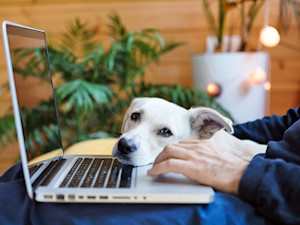Viral TikTok Challenge Asks: Would Your Dog Recognize You on the Street?
And got some pretty hilarious answers.
Telly is a senior one-eyed Beagle who is basically a little old man in canine form. We recently did the “walking past my dog” TikTok experiment, in which I walked him around his block in New York City. Meanwhile, his mom, Indiana, waited to pass us to see if Telly would recognize her.
“He won’t care,” his mom predicted, and she was right. Telly walked right by. Even when she called his name, he glanced back but carried on with his walk. (It is important to note here that despite having only one eye, Telly’s vision is excellent, and his mom predicts he kept walking because it was in the direction of home — that is, food.)
Trick question: All dogs are perfect! But find out which type is the best fit for you.
In a viral TikTok challengeopens in new tab, most dogs ran toward their pet parent when they walked by, but there are always the outliers like Telly who are in their delightfully spacey own little worlds. So, why do some dogs race to their parents, and why are some dogs more aloof?
Very unscientifically speaking (aka I made these up after observing these TikToks), there are three categories of reactions:
How much do you spend on your pet per year?
Reaction 1: Your dog is over the moon to see you.
Our dogs are, more often than not, thrilled to see us, and the dogs who have done this TikTok challenge are no exception. This Japanese Spitz below, for example, immediately started “doggie paddling” her legs, trying to get out of her holder’s arms to run to her person. Dogs who fall into this category simply cannot believe that your paths have crossed and that they’ve spotted you; what are the chances?!
There are a few theories as to how canines solve the mystery that the person walking past is their favorite person in the world — and one of them might be your shape or height.
“They look for, typically, at least one or two cues together to combine,” Dr. Andrew Findlaytoropens in new tab, chief veterinarian at Rooopens in new tab, says. “So, that could be our silhouette. I’m 6 foot 3, so from a distance, my dog — or my cat for that matter — is going to be like, ‘Hey, here comes a pretty tall guy that might be Dad.’”
Another reason your silhouette is so important is because dogs are less likely to see details, such as facial features, from afar. “Dogs have relatively poor visual acuity,” says Dr. Lore Haugopens in new tab, at VCA Lexington Blvd Animal Hospitalopens in new tab in Sugar Land, Texas. “As predators, their eyes are designed more to pick up motion and to be able to see better in low-light situations. So their ability to see fine detail is far more limited compared to a human.” She agrees with Dr. Findlaytor that dogs tend to recognize people visually first, “then use sound and odor to further clarify.”
So, after figuring out that the figure or silhouette could be their person, dogs probably move on to the next step, Dr. Findlaytor says, which is: “What else can I use to put this together?”
While smell also definitely comes into play (more on that in a minute) and it’s what people usually think of when they think of dogs recognizing us, it’s not the only factor: “They’re not in Super Smell Mode 24/7,” Dr. Findlaytor says. “I think that’d probably be overwhelming for them, so they’ll use it to put pieces of the puzzle together that they're already thinking of.”
Reaction 2: Your dog doesn’t notice you at first — and then…
Not all dogs can be as confident as this Chihuahua mix, who runs right up to his person. In fact, most pups seem to have a bit of a delayed reaction to what’s happening — you can almost see the wheels turning in their head. And then, like a switch is flipped, they run to their person.
That’s what happened with this little Frenchie, who literally did a U-turn when he realized he saw his person.
This Irish Setter was a little less confident but eventually made the decision to turn back, too.
“Every time it's like, ‘Wait a minute. I think that was Mom,’ but it doesn't hit them right away,” Dr. Findlaytor says. “And then they turn around to just put it all together. They probably put on hearing, smell, sight, all at once.”
That’s right: Our dogs might catch onto one cue first, but then they add other cues to crack the code. All the experts I spoke with agree that smell comes into play, and it’s quite likely that some of these dogs who do a double take are reacting to their person’s scent.
“Often this is due to the scent recognition as they near, but seeking confirmation by taking in another, purposeful sniff,” says Erin Askelandopens in new tab, certified dog trainer and behavior consultant at Camp Bow Wowopens in new tab. “Each person has a unique smell that dogs can distinguish even among other scents in the environment.” She notes that the sound of our voice and our unique movement patterns may also come into play.
“They’ll listen, not only for our voice, but even like the cadence of our steps, how we walk,” Dr. Findlaytor adds. However, he says, even if you happen to be on your phone as you walk by, you’re (hopefully) using your everyday voice and not the voice you probably speak to your dog in.
“You just can’t help but baby-talk to them,” he says. “But if you’re just using your normal voice, then I kind of feel like it goes with the rest of the pattern, where they’re like, ‘Well, it sounds like Dad’s voice, but do I see his silhouette? Do I smell him? Do I hear anything else? How can I add this all up to confirm what I’m suspecting?’”
Reaction 3: Your dog doesn’t care or is just chill about it.
This Frenchie (a separate, perhaps less aware pup than the other Frenchie above) was having a lovely walk. And while she certainly loves her mom, she wasn’t going to let anything get in the way of a delightful stroll. “She walked right past me!” says her mom in the TikTok, after her pup trotted right by.
That dog would probably get along great with Telly, the one-eyed Beagleopens in new tab, who was probably thinking about home and what was in his food bowl more than stopping to say hello to his mom.
This might not be all that surprising, since Dr. Findlaytor says that brachycephalic breeds, like Frenchies and Pugs, tend to have a diminished sense of smell, so they’re missing out on a cue. Telly, too, has reduced vision. But it also could be based on personality — and it doesn’t mean your dog adores you any less.
“Some dogs may be naturally more independent or less obvious in their affections. However, this doesn't mean they don't appreciate or recognize their person; they may just show it differently,” Askeland says. “This doesn’t make them aloof; often it makes them well-adjusted.”
That’s good news for that Frenchie above — and Telly, a dog who’s definitely well-adjusted.
What do these different reactions mean?
As hard as it may be, it’s best not to read into it.
Dr. Findlaytor says that some dogs are, adorably, just “goobers” who go about their day in their own world. Just like in humans, Dr. Haug adds, “attention and focus” come into play when processing stimuli. “For example, if a person is very distracted focusing on their phone, they may walk by a familiar individual and not even register that the other person is there,” she says. “A similar situation can happen with dogs.”
So, if your dog ignores you, chances are they’re either a daydreamer (adorable) or just distracted by something else (a butterfly). Either way, it’s usually nothing to worry about, Askeland says: “This doesn’t mean they don’t love their person.”
Phew.








